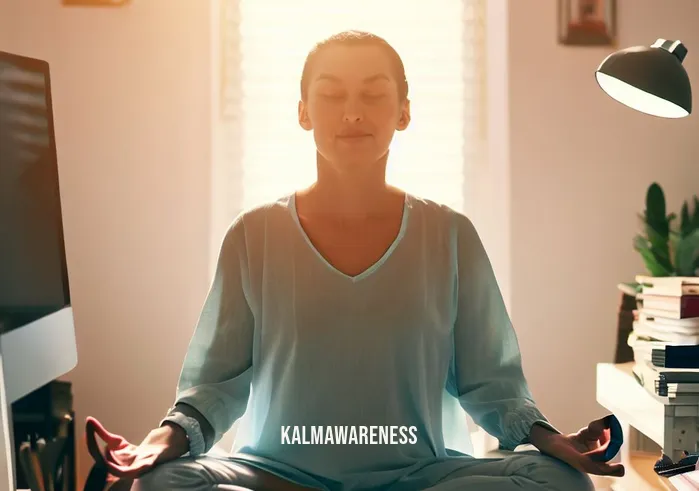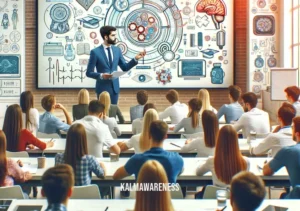Crafting Your Meditation Lesson Plan: A Journey to Inner Peace
Meditation is not just an art; it’s a science of the mind. An effective meditation lesson plan is a journey into self-discovery, fostering harmony and balance within us. Today, we’ll guide you on crafting an impactful meditation lesson plan that promises not just relaxation, but a profound understanding of the self.
Begin with Understanding
A meditation lesson plan begins with understanding the core purpose of the practice. It is not merely to “relax”, but to achieve a state of deep relaxation that permeates our being and touches every aspect of our lives. This deep relaxation is not an end state but rather the beginning of a beautiful journey towards greater awareness and inner tranquility.
Meditation also involves the practice of mindfulness. In this sense, mindful education forms the bedrock of any meditation lesson plan. The mindful education transcript provides an illuminating guide on embedding mindfulness into your lesson plan.
Key Components of a Meditation Lesson Plan
An effective meditation lesson plan is multi-dimensional, encompassing various facets.
1. Introduction to Meditation
Begin your lesson plan by introducing meditation and its myriad benefits. Explain how the practice helps attain brainwave entrainment and how it can induce deep states of relaxation. Our article on brainwave entrainment provides scientific insights into the subject.
2. Understanding the Mind-Body Connection
Meditation is a journey into the self, and understanding the mind-body connection is crucial. Incorporate Joe Dispenza’s principles on brain and heart coherence into your lesson plan.
3. Breathing Techniques
Breathing exercises form the core of meditation practices. Teach various breathing techniques and explain their impact on calming thoughts. Our guide on Baoding balls use can provide additional tools for achieving calmness.
4. Guided Visualization
Guided visualization exercises such as the Bubble Protection technique can enhance the meditation experience. They allow practitioners to create a safe space within their minds, fostering feelings of peace and security.
5. Body Relaxation Techniques
Body relaxation techniques like caressing the face can serve as useful additions to your meditation lesson plan. These techniques help relax the body and prepare the mind for meditation.
6. Mindfulness Exercises
Incorporate mindfulness exercises into your lesson plan. These exercises help practitioners anchor their minds in the present, fostering a sense of presence and calm. The mind-ease method offers a practical approach to cultivating mindfulness.
We hope this guide helps you craft a comprehensive and engaging meditation lesson plan. We invite you to continue to the next part of the article, where we delve into the practical aspects of delivering your lesson plan, how to assess progress, and much more.
–
Practical Aspects of Delivering Your Meditation Lesson Plan
After carefully crafting your meditation lesson plan, it’s time to bring your plan to life. A successful meditation session goes beyond following the lesson plan verbatim – it’s about creating a supportive and nurturing environment, fostering open communication, and being responsive to your students’ needs.
Creating the Right Environment
The ambiance of the meditation space greatly affects the effectiveness of your session. A serene environment can enhance the feeling of deep relaxation, making it easier for participants to calm their thoughts and focus on their inner self. You might consider incorporating soothing music or nature sounds to set a peaceful mood.
Fostering Open Communication
Establishing open communication is key in a successful meditation lesson plan. It’s important to create a space where participants feel comfortable sharing their experiences and concerns. Discussing the science behind the practice, for instance, the brain wave entrainment technique, can help demystify meditation and make it more approachable.
Being Responsive to Students’ Needs
Each participant in your meditation session will have unique needs and challenges. Some may struggle with calming their thoughts while others might find it difficult to visualize during guided meditations. As a meditation guide, you should be responsive to these needs and ready to provide alternative techniques or exercises. For example, you might recommend the Emotional Reset Technique for those having difficulty managing their emotions during meditation.
Assessing Progress in Your Meditation Lesson Plan
Monitoring your participants’ progress is an essential aspect of delivering your meditation lesson plan.
Participants’ progress can be gauged in various ways. For instance, the Name It, Tame It, Reframe It method is an effective tool for monitoring progress. It provides a framework for individuals to identify, manage, and shift their perspectives on their thoughts and emotions.
Another important factor to consider is sleep quality. Regular meditation can enhance the quality of sleep. Techniques like savoring sleep can be taught as part of the meditation lesson plan, and improvements in sleep can be a good indicator of progress.
Additionally, encourage participants to maintain a meditation journal. This can be a valuable tool for self-reflection and tracking progress. Journal entries can provide insights into how individuals are responding to various techniques and exercises.
Finally, remember that progress in meditation is often subtle and gradual. As the guide, remind your students to be patient with themselves and to recognize and celebrate small victories.
We’ve covered a lot in this section, and we hope these tips enhance your meditation lesson plan. Join us in the next part where we’ll discuss integrating meditation into daily life and how to sustain meditation practice long term.
–
Integrating Meditation into Daily Life: Meditation Lesson Plan Continued
So far in your meditation lesson plan, you’ve learned about setting up a conducive environment, maintaining open communication, being responsive to students’ needs, and assessing progress. Now, it’s time to look at integrating meditation into daily life, a key factor in sustaining meditation practice long term.
Maintaining Consistency in Practice
Consistency is crucial in meditation practice. It is beneficial to find a regular time and place to meditate every day. Whether it’s first thing in the morning, during a lunch break, or before bed, the important thing is to make it a routine. This helps train the brain to enter a meditative state more easily. In fact, Brain and Heart Coherence – a practice that promotes harmony between the mind and heart – benefits greatly from regular practice.
Making Use of Mini-Meditation Sessions
Even in a hectic schedule, mini-meditation sessions can prove to be a game-changer. Brief moments of mindfulness, such as the practice of Caressing Face, can be interspersed throughout the day. This not only reduces stress but also keeps the mind centered and focused.
Using Mindful Tools
Mindful tools like Baoding balls can be incorporated into your meditation lesson plan. They can be used during breaks or while engaging in mindful activities, serving as a constant reminder to stay present.
Sustaining Meditation Practice Long Term
Sustaining a meditation practice long term requires commitment, motivation, and understanding the benefits of meditation on a deep, personal level. Here are some strategies to help:
Cultivating a Meditation Community
A supportive community can significantly enhance the meditation experience. Sharing experiences and challenges with others on the same journey can provide encouragement and motivation. Communities can be physical groups or virtual ones, such as the Mindful Education Transcript online forum.
Continual Learning and Adaptation
Just like any skill, meditation requires continual learning and adaptation. Expanding knowledge on subjects like the good and the beautiful space science of meditation can renew interest and deepen understanding.
Overcoming Hurdles
Every meditator faces challenges. Understanding how to keep composure in the face of distractions or emotional upheavals can be a turning point in the meditation journey.
Implementing this advice in your meditation lesson plan will surely aid in the overall effectiveness of your sessions. In the next section, we will delve into meditation’s science-backed benefits, and you’ll get insights into how a well-executed meditation lesson plan can lead to impressive results. Stay tuned!
–
Unraveling the Benefits of a Meditation Lesson Plan
Having spent time understanding how to effectively integrate meditation into daily life, let’s now explore the numerous benefits that can be realized through a well-executed meditation lesson plan. The impacts of meditation are vast and deeply transformative, influencing both mental and physical wellbeing.
Promoting Mental Wellness
A key outcome of a meditation lesson plan is enhanced mental wellness. Regular meditation can foster a state of Deep Relaxation, reducing stress and anxiety. This practice can also lead to the cultivation of Calm Thoughts and greater emotional balance, as meditation encourages a deeper awareness of emotional states, and aids in their regulation.
Fostering Emotional Resilience
The emotional resilience cultivated through meditation is vital in managing life’s ups and downs. Techniques like the Emotional Reset Technique can be invaluable tools for emotional self-regulation, and they form an integral part of a comprehensive meditation lesson plan.
Enhancing Brain Function
Meditation has profound effects on the brain. Brainwave Entrainment and Brain Wave Entrainment are concepts that describe the brain’s capacity to synchronize its brainwave frequencies with the rhythm of external stimuli. This synchronization can improve focus, creativity, and overall cognitive function.
Supporting Physical Health
The impacts of meditation aren’t limited to mental and emotional wellbeing; physical health also reaps its rewards. Techniques such as Clear Heel Taps can promote groundedness, improving balance and stability.
Cultivating Mind-Body Connection
Through practices like the Euphoria Relaxation, the mind-body connection can be significantly enhanced. This greater unity can foster increased self-awareness and a deeper sense of harmony and peace.
Incorporating Advanced Techniques
A meditation lesson plan can also include advanced techniques, such as the Bubble Protection and Bubbleprotection methods, which are designed to fortify the mind against external distractions and disturbances.
The benefits of a well-executed meditation lesson plan are extensive, touching upon almost every aspect of human life. In our next chapter, we’ll focus on scientific research that provides concrete evidence of these benefits, discussing significant studies and the revelations they have brought about. Stay tuned to delve deeper into the science of meditation!
–
The Science Behind Meditation Lesson Plan
When designing a meditation lesson plan, it’s essential to incorporate techniques backed by scientific research. Over the years, studies have illuminated the far-reaching benefits of meditation, revealing the mechanisms through which this ancient practice can enhance overall well-being.
Meditation and the Brain
Researchers have made significant strides in understanding the neural mechanisms behind meditation’s benefits. Studies indicate that consistent meditation practice can change the brain’s structure and function for the better. This aspect of meditation is well-covered in a discussion on Brain and Heart Coherence, an essential concept that illustrates the harmonious interaction between the heart and brain achieved through meditation.
Emotional Intelligence and Meditation
The science behind the practice of meditation reveals an interesting correlation with emotional intelligence. Techniques, such as the one shared in Name it, Tame it, Reframe it, help individuals identify, understand, and manage their emotions effectively. This emotional intelligence is a key factor in achieving personal and professional success, and it’s something that a well-planned meditation lesson plan can cultivate.
Mindful Education
The adoption of meditation in educational settings has become more prevalent, recognizing the benefits of mindfulness for students. As pointed out in this Mindful Education Transcript, mindfulness programs have been introduced in schools worldwide, contributing to better concentration, reduced stress, and improved behavior among students.
The Power of Baoding Balls
An essential element of a meditation lesson plan could be the use of tools that assist in achieving a meditative state. For instance, Baoding Balls can be used in conjunction with meditation for enhanced effects. The rhythmic movement of these balls can stimulate various parts of the brain, promoting relaxation and concentration.
Meditation in Sports
Even in the world of sports, the efficacy of meditation cannot be ignored. As discussed in How to get out of your head in sports, meditation techniques help athletes achieve a state of ‘flow’, enhancing their performance and ability to handle pressure.
A Global Discussion
The widespread recognition of meditation’s benefits is evidenced by numerous TED Talks dedicated to the subject. Refer to Meditation TED Talk and Ted Talk Meditation for some insightful discussions by experts in the field.
To conclude, a scientifically-backed meditation lesson plan is essential for maximizing the benefits of this practice. In the next part of this article, we’ll take a deeper look at creating a personalized meditation lesson plan, offering useful tips to guide you on your journey to enhanced well-being. So, stay with us as we continue this enlightening exploration!
–
Crafting Your Personalized Meditation Lesson Plan
Designing a meditation lesson plan that suits your unique needs can be a deeply transformative experience. This process allows you to identify your goals, needs, and preferences, leading you toward a practice that will effectively serve your wellness journey.
Starting Your Day with Meditation
Mornings are an ideal time to begin your meditation practice. As pointed out in the blog post on Calm Thoughts, starting your day with meditation sets a positive tone for the rest of the day. Your meditation lesson plan could involve carving out a specific time each morning dedicated solely to your practice.
Implementing Relaxation Techniques
Your meditation lesson plan may incorporate a variety of relaxation techniques. Techniques like Deep Relaxation and Euphoria Relaxation can significantly reduce stress levels and boost overall well-being. It’s important to experiment with different techniques to discover what resonates most with you.
Employing Breathing Techniques
In your meditation lesson plan, you should also consider including specific breathing techniques. The use of Bubble Protection and BubbleProtection techniques can enhance your meditation experience, leading to deeper levels of calm and focus.
Integrating Mindfulness Into Daily Activities
One key aspect of an effective meditation lesson plan is the integration of mindfulness into your daily life. You can take inspiration from the article on Caressing Face to practice mindfulness during simple tasks. Mindfulness brings your attention to the present moment, allowing you to fully engage with your experiences and react more thoughtfully to events.
Utilizing Technological Tools
Modern technology provides various tools that can enhance your meditation practice. For example, Brainwave Entrainment and Brain Wave Entrainment offer audio stimulation that synchronizes with your brainwaves to facilitate a deep meditative state.
Cultivating A Nightly Routine
Finally, consider concluding your day with a period of meditation as part of your lesson plan. Techniques like Savoring Sleep can help improve your sleep quality, ensuring you wake up refreshed and ready for the next day.
In creating your meditation lesson plan, remember that the journey to enhanced well-being is unique for each individual. Stay open to trying different techniques and approaches until you find what works best for you. In the next part of this article, we will delve into additional elements you may want to incorporate into your meditation lesson plan to further enrich your practice. So, continue to stay with us on this journey of discovery and personal growth.
–
Incorporating Emotional Management Techniques in Your Meditation Lesson Plan
Equipping yourself with emotional management strategies in your meditation lesson plan can significantly improve your ability to navigate through life’s challenges with grace and composure. These techniques, when skillfully integrated into your daily routine, can help facilitate personal growth and emotional resilience.
Understanding the Power of Naming Emotions
In the realm of emotional management, the concept of “Name it to Tame it” is incredibly powerful. The Name it Tame it Reframe it technique highlights the importance of recognizing and naming your emotions as a crucial first step in effectively managing them. By including this strategy in your meditation lesson plan, you can develop a deeper understanding of your emotional landscape and navigate it more effectively.
Utilizing Emotional Reset Technique
The Emotional Reset Technique is another valuable tool you can integrate into your meditation lesson plan. This technique aids in releasing accumulated emotional tension, promoting greater emotional equilibrium. By routinely practicing this technique, you can cultivate an enhanced ability to rebound from emotional upheaval.
Maintaining Composure in Stressful Situations
Life is fraught with stressful situations, and maintaining composure can sometimes feel like an uphill battle. However, How to Keep Composure offers valuable insights on maintaining calm under pressure, making it a must-add to your meditation lesson plan. By practicing these techniques, you can develop a robust resilience to stress, boosting your overall well-being.
Engaging the Mind-Body Connection
The connection between the mind and body is profound, and the integration of physical techniques in your meditation lesson plan can promote a deeper sense of tranquility. Techniques such as Clear Heel Taps serve to ground you, creating a comforting sense of connection with the world around you.
Incorporating Mindfulness in Sports
For the athletes among us, mindfulness can greatly enhance performance. How to Get Out of Your Head in Sports provides a wealth of information on this topic, making it a beneficial inclusion in your meditation lesson plan, particularly if physical activity is a substantial part of your lifestyle.
Exploring the Science of Meditation
Finally, gaining a deeper understanding of the science behind meditation can enhance your commitment and dedication to your practice. The Meditation Ted Talk and Ted Talk Meditation links provide thought-provoking insights into the neurological effects of meditation, validating its numerous benefits.
With these strategies incorporated into your meditation lesson plan, you’re well-equipped to navigate the path towards emotional well-being and personal growth. Remember, the journey towards mindfulness is deeply personal, and it’s important to continually adapt and adjust your plan as you evolve and grow.
This concludes our in-depth exploration into crafting an effective and personalized meditation lesson plan. We hope this guide has provided you with valuable insights and actionable steps to develop a meditation practice that resonates deeply with you. Continue to explore and embrace the journey towards mindfulness, serenity, and overall wellness.





